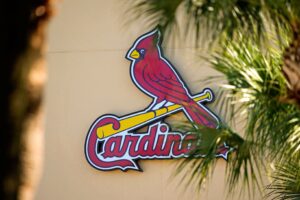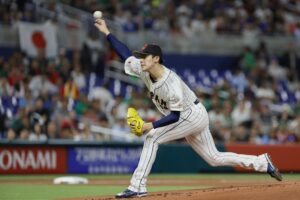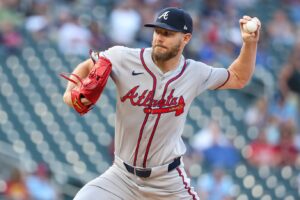The Chicago Cubs have built a solid lineup core around Nico Hoerner, Dansby Swanson, Ian Happ, and Seiya Suzuki. Their starting rotation features Justin Steele, Shota Imanaga, and Javier Assad. Despite being ravaged by injury this season, the bullpen currently sports the best ERA in MLB. Yet the Cubs still find themselves in the midseason doldrums that have plagued them the past few years. In a recent “Jed” Talk, Cubs PBO Jed Hoyer signaled the team is focused on the future. So what does that future look like? Let’s assess the potential of the Cubs farm system as it stands.
The Future of the Cubs Farm System
Solid Farm Systems Tend to Produce Winning Ball Clubs
At the start of the 2024 season, MLB ranked the Cubs farm system number two in the majors, behind only the Baltimore Orioles. The last time the Cubs were ranked this high was prior to the 2015 season, when they ranked first on the MLB Pipeline list. The next year they won their first World Series in 108 years. Since 2015, teams that ranked first in pre- or mid-season have won four World Series, and consistently tied or set franchise records for wins and/or postseason appearances.
The Orioles system features only three prospects in the Top 100, but all three rank in the top 15, including the number one prospect Jackson Holliday. The Cubs on the other hand had seven players ranked in the Top 100, the most of any ball club.
What’s more, after promoting center fielder Pete Crow-Armstrong (No. 16), and Michael Busch (No. 51) to the big league club, the Cubs’ total remained at seven. 20-year-old catcher Moises Ballesteros (No. 59) and 19-year-old shortstop Jefferson Rojas (No. 85) have since taken up residence in the Top 100.
Pete Crow-Armstrong just scored from 1st on a single. And it wasn’t close. ??? pic.twitter.com/ZEJ5bSIhdr
— Ben Ross (@BenRossTweets) June 27, 2024
Building Depth Throughout the Roster
One obvious deficiency for the Cubs this season has been at third base. Cubs manager Craig Counsell has been platooning Christopher Morel, David Bote, Miles Mastrobuoni, and Patrick Wisdom at the position throughout the season. But his search has so far yielded little in the way of hitting consistency.
The selection of Florida State University star third baseman Cam Smith with their first pick (14th overall) in the 2024 draft indicates the front office has acknowledged this problem. Doubling down on that front, they later selected College of Charleston third baseman Cole Mathis with the 54th pick. Whether or not either is a long-term solution at the hot corner remains to be seen.
The Chicago Cubs select Cam Smith out of FSU with the 14th pick!
The 6’3, 229lb 3B had a .258 BA w/12 HR last season.
Welcome to Chicago! pic.twitter.com/sQWfJ5SXld
— Just Another Year Chicago: Cubs (@JAYChiCubs) July 15, 2024
According to one MLB.com insider, the Cubs’ current list of prospects includes “much more pitching depth, which could help them build a longer-term contender.” Here again, the Cubs looked to acquire more depth this season, drafting nine pitchers alongside the seven infielders, two outfielders and two catchers selected in this year’s draft.
Seeking the Future in the Present
Despite what seems like good news for future prospects, questions abound about the Cubs in the present. They are sorely lacking in hitting depth, slashing well below league average in the six through nine slots in the lineup. They need a big bat presence in the lineup as well. A player with 30-plus home run potential.
A catcher with a plus arm and a dependable bat would be a nice addition as well. However, rookie Miguel Amaya is at least showing signs of progress at the plate. Since taking a few days off to rework his swing, Amaya has had an astonishing seven-game tear, slashing .643/.722/.827. More bullpen depth with big arms will be a key moving forward as well.
The Cubs could answer some of these questions through the remainder of this season. Dansby Swanson has been abysmal at the plate so far, and Cody Bellinger has been up and down with injuries. When healthy, Bellinger is capable of supplying that big bat the Cubs need. And Swanson, a usually reliable hitter, could easily find his form again.
Trades Can Leave More Questions Than Answers
Of course, there’s also the possibility of a trade that could produce cap space for acquisitions in the offseason. Cubs third starter Jameson Taillon‘s name is going around the rumor mill, for instance. A trade involving Taillon isn’t likely to bring a long-term solution at third base, however.
They could let a marquee infielder like Hoerner go, possibly in a trade with Taillon. That might fetch some real talent, and the Cubs have plenty of depth at second base. Michael Busch is a natural second baseman and he is definitely a big league hitter. Cody Bellinger is probably safer at first base, and Crow-Armstrong is developing as a big-league center fielder.
Do you play for the big-time talent and shake up the core of your team, or roll the dice on your homegrown talent?
Hoyer has plenty of critics who crucify him for his stilted approach to personnel moves. This is baseball. There are no guarantees. But the Cubs are quietly (or maybe not so quietly) building a solid farm system that may lead to years of winning baseball.
Photo Credit: © Matt Marton-USA TODAY Sports






